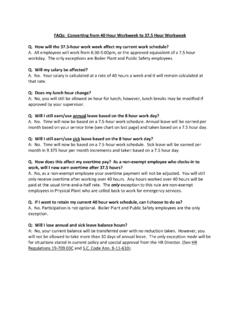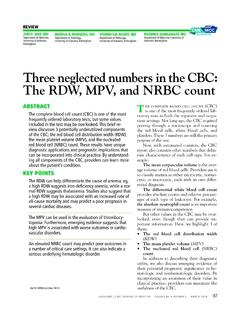Transcription of A GUIDE TO BEING A CADET NCO - The Citadel
1 A GUIDE TO BEING ACADET NCO (NONCOMMISSIONED OFFICER) at The CitadelLEADSERVEENGAGEPREPAREFITNESSMILI TARYCHARACTERACADEMICSHONOR DUTY RESPECTTHE Citadel EXPERIENCE2020 principled leader development Follow me and do as I do. This iconic statue at Fort Benning, Georgia represents the essence of the NCO leadership ethos and serves as the standing orders of NCOs everywhere to the men and women entrusted to their OF CONTENTSI ntroductionChapter 1 The Officer/NCO Team ..3 Chapter 2 The NCO and the Daily Business of the Corps ..10 Chapter 3 The NCO and Individual and Small Team Training 36 Chapter 4 The NCO and CADET Development.
2 46 Chapter 5 The NCO and Getting the Job Done ..49 Chapter 6 Specific Duty Positions and Responsibilities ..522 IntroductionA GUIDE to BEING a CADET NCO at The Citadel builds on CADET Leader Development AY 2017-2018, The Citadel Training Manual, and How to Train at The Citadel to provide specific guidance for how a CADET NCO implements the principles contained in those documents. It is designed to serve as the reference text for the Corporal and Sergeant Academies that cadets participate in as they transition from BEING freshmen to sopho-mores and from sophomores to juniors, and it is the sister manual to A GUIDE to BEING a CADET Officer at The GUIDE to BEING a CADET NCO at The Citadel has six chapters.
3 Chapter 1 is The Officer/NCO Team. This chapter explains the principle dif-ferences between a CADET NCO and a CADET officer. It identifies what is traditionally considered NCO Business relative to Officer Business and explains in general terms how NCOs and officers achieve unity of effort within this division of 2 is The NCO and the Daily Business of the Corps. Chapter 3 is The NCO and Individual and Small Team Training. Chapter 4 is The NCO and CADET Development. Chapter 5 is The NCO and Getting the Job Done. Each of these chapters discusses the particular aspect of NCO Business, in many cases using Citadel examples and pro-viding insights into best 6 is Specific Duty Positions and Responsibilities and it provides a brief description of the expectations for each NCO position within the South Carolina Corps of 1 The Officer/NCO TeamWhile the NCO is often referred to as the backbone of the Army, the officer/NCO team has been described as its cornerstone.
4 A strong officer/NCO bond can have the single most important impact on unit effectiveness and efficiency. Conversely, if the bond is broken, it can have a devastating impact on morale, esprit de corps, readiness and mission accomplishment. Of particular importance are the bonds between Platoon Sergeant and Platoon Leader, First Sergeant and Company Commander, Battalion CSM and Battalion Commander, and Regimental CSM and Regimental many very important ways, the officer/NCO relationship at The Citadel is different from that in the military. In the military, NCOs have advanced up the ranks and by that process gained experi-ence, technical and tactical expertise, and personal power that a junior officer, who has only recently entered the service directly from a commissioning source, does not have.
5 NCOs in the mili-tary are largely responsible for training and mentoring not only other enlisted personnel in their charge, but also the new officers. Officers in the military have significant responsibilities for collec-tive training and The Citadel , the differential between the practical experience of officers and NCOs is actually the reverse of the way it is in the military. CADET officers were generally CADET NCOs the previ-ous year and likely know more about NCO duties than the CADET NCO does. Therefore, the CADET officer can receive little training or experiential wisdom from the CADET NCO.
6 In fact, the opposite 1 TC 7-22 .7, Noncommissioned Officer GUIDE (Washington, DC: DOA, 5015), 5-4 .4relationship exists. Finally, most of the training that goes on at The Citadel occurs at the individual or small unit result of these dynamics is that at The Citadel , CADET offi-cers often tend to default to what they know how to do and what needs to be done, and those things are usually part of what in the military would be considered NCO Business. When CADET officers do what CADET NCOs should be doing, not only are the NCOs underutilized , the tasks the officers should actually be doing are neglected .
7 NCOs and officers must be very sensitive to this Citadel -specific reality as they forge their relationship, and consider it in the context of the principled leadership behavior of keeping a balanced view of one s own importance. NCO Support Channel. The NCO Support Channel is a leadership channel that parallels, supports, reinforces, and complements the chain of command, but is subordinate to it. This channel of communications and supervision begins with the com-mand sergeant major, extends through first sergeants and platoon sergeants, and ends with squad leaders and squad corporals.
8 It is used to pass information, execute the commander s orders, and to get routine jobs In the context of principled leadership behaviors, the NCO Support Channel impacts empowering others for action and decision-making as well as holding team members accountable for results. At The Citadel , the Commandant Department Sergeant Major, the Battalion TAC NCOs, and the staff NCOs form a NCO Support Channel that begins the process of putting into effect the policies and procedures determined by the Commandant and the Battalion and Company TAC Officers, and enforcing standards of perfor-mance, training, appearance, and conduct.
9 The NCOs monitor the process and provide the chain of command feedback and advice about its implementation. This Commandant Department NCO 2 TC 7-22 .7, 4-19 .5 Support Channel interacts with the CADET NCO Support Channel by frequent CSM/1SG meetings, NCO calls, and individual meetings between CADET NCOs and their Commandant s Department coun-terparts. When the Regimental CSM passes on information to the Battalion CSMs from or through these forums, he or she does not do so as a member of their chain of command. The Battalion CSMs have that relationship with their Battalion Commanders. Instead, the Regimental CSM is acting as a member of the NCO Support Channel to support the chain of command.
10 He or she is able to do so both based on their experience and position, but also based on his or her synchronization with the Regimental Commander as a result of their special NCO and Officer Unity of Effort. Dandridge Malone uses the phrase vertical teamwork to describe the unity of effort between officers and NCOs. He identifies four things necessary for vertical teamwork to happen: Knowing each other. Practicing the basic process of getting things done together. Knowing how the chain of command and the NCO support channel work. Knowing the difference between what officers do and what NCOs and officers come to know each other the same way anyone does: they talk, share experiences, spend time together, and make adjustments as they go along.










